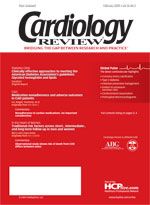Publication
Article
Cardiology Review® Online
Multislice CT angiography for the diagnosis of coronary artery disease: Are we there yet?
Author(s):
Despite advances in cardiac testing, noninvasive methodologies remain limited in their accuracy to (1) determine the etiology of chest pain; (2) detect preclinical coronary artery disease; and (3) track the progression of atherosclerotic lesions in native and revascularized coronary vessels.
Despite advances in cardiac testing, noninvasive methodologies remain limited in their accuracy to (1) determine the etiology of chest pain; (2) detect preclinical coronary artery disease; and (3) track the progression of atherosclerotic lesions in native and revascularized coronary vessels. Exercise treadmill testing, stress nuclear, and stress echocardiographic testing each have limited sensitivity and specificity to recognize “significant” (usually >70%) coronary luminal narrowing. Though these tests may identify patients with ischemic-producing lesions, none provide information about “preclinical atherosclerosis” (coronary narrowing <50%). Newer technologies to detect early atherosclerosis include electron beam (ultrafast) computed tomography (EBCT) and cardiac magnetic resonance imaging (MRI). Electron beam computed tomography detects focal calcium deposits in the coronary tree that are surrogate markers for preclinical and clinical atherosclerosis. Electron beam computed tomography, however, has low sensitivity, especially in young patients, and low specificity, particularly in diabetics. Furthermore, EBCT does not quantify lesion obstruction. In contrast, cardiac MRI provides detailed images of the myocardium, chambers and valves, but, thus far, magnetic resonance angiography has not been able to provide diagnostic coronary images due to limited imaging spatial resolution, motion artifacts, and long scan times.
In the past 5 years, multislice computed tomography (MSCT) scanning has evolved as a potential new methodology to provide improved detailed diagnostic noninvasive imaging of the coronary anatomy. The first-generation 4-slice computed tomagraphy scanners showed promise but suffered from poor temporal resolution (250 millisecond). With the advent of the second-generation 16-slice scanners, imaging of the proximal large caliber coronary vessels has improved but has limited accuracy quantifying lesions in the smaller distal vessels, especially when the heart rate is above 60 beats/minute.1 Sensitivity and specificity of 4- and 16-slice CT scanners have been reported as 82% to 95% and 82% to 98%, respectively, but these data are limited to patients with heart rates <65 beats/min and proximal vessels >1.5 to 2.0 mm.1-5
The newest 64-slice CT technology has improved spatial and temporal resolution with the potential to provide high-quality visualization of the entire coronary tree. The 64-slice detectors permit shorter breath hold time, typically 15 seconds, thereby reducing respiratory artifacts. These latest generation machines also reduce cardiac motion artifacts by accelerating gantry rotation and enhance spatial resolution by decreasing slice thickness. These technical advances allow MSCT to approach the quality of invasive coronary angiography. The 64-slice CT and invasive coronary angiography have a spatial resolution of 0.4 mm versus 0.25 mm respectively, and 6-millisecond versus 85- to 165-millisecond temporal resolution, respectively.
The study by de Feyter and colleagues reported in this journal assessed the diagnostic power of the newest generation 64-slice CT technology in patients with atypical chest pain, chronic angina, or acute coronary syndromes undergoing coronary angiography. The majority of screened subjects (74%) were eligible for CT study. Patients considered ineligible for MSCT angiography included those with contrast allergy, renal insufficiency, arrhythmias, or logistic difficulties. Technical success was high (98%). Even though 64-slice CT has faster scan times, beta blocker use was required in 73% of patients studied so as to maintain a resting heart rate < 70 beats/min and enhance image quality. de Feyter took on the challenge to image the entire length of all coronary arteries, analyzing all 16 cardiac segments (American Heart Assoication mode). Sensitivity and specificity to detect coronary stenoses ≥50% was 99% and 95%, respectively. All 12 patients with normal or minor coronary artery disease (CAD) were properly categorized except for 1 patient for whom MSCT overestimated the lesion. All patients with >50% lesion were correctly identified including those in the small distal and side branches. The authors conclude that 64-slice CT is “highly reliable to rule out the presence of significant coronary stenosis.”
Using similar 64-slice technology, Leber et al compared CT with quantitative angiography and intravascular ultrasound.6 Leber et al reported lower sensitivity (73%) for 64-slice CT but similar specificity (97%) compared to de Feyter’s report. As expected, proximal lesions were identified better than those in distal segments (sensitivity 75% and 67%, respectively). Measurement of plaque volume by MSCT also correlated well with intravascular ultrasound. Of note, the studies by both de Feyter and Leber had high prevalences of CAD, which could overestimate the predictive accuracy of this methodology with other patient populations.
Limitations of MSCT angiography exist even with the newest 64-slice systems. Severe calcification impairs diagnostic accuracy. Focal calcification creates “partial volume effect,” whereby pixels look excessively bright resulting in lower spatial resolution and overestimation of stenoses. Although calcium produces artifact even with 64-slice technology, this is somewhat reduced since the image is made up of smaller pixels. Another drawback of MSCT is the radiation exposure to the patient. Hunhold reported radiation exposure of 15.2 to 21.4 mSv during cardiac CT studies.7 This level of radiation is significantly higher than that with fluoroscopy during an average cardiac catheterization. Radiation exposure during MSCT can be partially reduced using electrocardiogram-controlled tube current modulation, whereby radiation is limited to the diastolic phase of the cardiac cycle.8
Early experience with 64-slice CT imaging of native coronaries is very encouraging. Multislice CT may even have advantages over traditional invasive coronary arteriography by demonstrating a cross-sectional view of coronary vessels, imaging both plaque volume and the vessel wall. Leber et al6 demonstrated a correlation of 64-slice CT compared with intracoronary vascular ultrasound (r = 0.71). Multislice CT, however, has not been shown to identify vulnerable plaque.
As MSCT improves, it will be important to determine for which patients this test is appropriate. Large-scale screening for CAD with MSCT is not indicated. Patient selection should target those individuals for whom the diagnostic information outweighs the radiation exposure.






